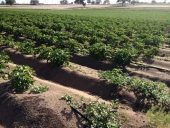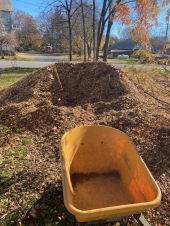
 35
35




www.composterconnection.com wrote:Pound for pound, the leaves of most tress contain twice the mineral content of manure...And they provide the perfect nutrition for beneficial microbes. In short, they make soil come alive.
Seed the Mind, Harvest Ideas.
http://farmwhisperer.com
 4
4




 5
5




 2
2





 1
1




For unlimited return on all your investments - Make your deposits at 'The Entangled Bank' !
 1
1






 4
4




John Polk wrote:Nice thread. Leaf mold is a great soil amendment. For fastest decomposition, leaves need to be in direct contact with the soil.
Urine will greatly speed up the decay...a little nitrogen does wonders for the process.
Seed the Mind, Harvest Ideas.
http://farmwhisperer.com
 1
1





 2
2




Seed the Mind, Harvest Ideas.
http://farmwhisperer.com
 4
4




Vic Johanson
"I must Create a System, or be enslaved by another Man's"--William Blake





Seed the Mind, Harvest Ideas.
http://farmwhisperer.com





For unlimited return on all your investments - Make your deposits at 'The Entangled Bank' !
 4
4




Brenda
Bloom where you are planted.
http://restfultrailsfoodforestgarden.blogspot.com/
 9
9




Certifiable food forest gardener, free gardening advice offered and accepted. Permaculture is the intersection of environmentalsim and agriculture.
 1
1




Certifiable food forest gardener, free gardening advice offered and accepted. Permaculture is the intersection of environmentalsim and agriculture.
 2
2




Get involved -Take away the standing of corporations MovetoAmmend.org

 10
10




White-rot fungi break down the lignin in wood, leaving the lighter-colored cellulose behind; some of them break down both lignin and cellulose.[2] Because white-rot fungi are able to produce enzymes, such as laccase, needed to break down lignin and other complex organic molecules, they have been investigated for use in mycoremediation applications.
Honey mushroom (Armillaria ssp.) is a white-rot fungus notorious for attacking living trees. Pleurotus ostreatus and other oyster mushrooms are commonly cultivated white-rot fungi,[4] but P. ostreatus is not parasitic and will not grow on a living tree, unless it is already dying from other causes. Other white-rot fungi include the turkey tail, artist's conch, and tinder fungus.
Seed the Mind, Harvest Ideas.
http://farmwhisperer.com
 9
9




 i think many of you have hit the nail on the head with many of the idea's , I'd just like to take this time to highlight some important uses
i think many of you have hit the nail on the head with many of the idea's , I'd just like to take this time to highlight some important uses


 2
2




Seed the Mind, Harvest Ideas.
http://farmwhisperer.com
 2
2






 1
1




Seed the Mind, Harvest Ideas.
http://farmwhisperer.com










 1
1




Seed the Mind, Harvest Ideas.
http://farmwhisperer.com





Seed the Mind, Harvest Ideas.
http://farmwhisperer.com
 2
2




Ken Peavey wrote:It's leaf season.
Get yourselves a few tons of leaves while the gettin is good.
 1
1




I also write a blog (in Spanish) about urban cycling @ https://medebici.blogspot.com




Juan Sebastian Estrada wrote: but I would really like to speed up the process





Juan Sebastian Estrada wrote:I would really like to speed up the process
Seed the Mind, Harvest Ideas.
http://farmwhisperer.com




Ken Peavey wrote:
Inoculation with leaf mold tea will help. You would be increasing the fungi population as well as the moisture in the heap. Moisture looks to be the critical factor. A dry heap, even well innoculated and teeming with spores will be slow to decompose. As with compost, the material needs to be about as damp as a wrung out sponge. This is around a 25% moisture level. For a pound of leaves this requires around a quarter pound of water. A heap of several cubic meters will take a lot of water.
There is nothing wrong with using those leaves now. Shovel em up, spread around your trees. They'll decompose wherever they are. Worms and bugs will move the leaves into the soil and the soil into the leaves.
I also write a blog (in Spanish) about urban cycling @ https://medebici.blogspot.com
 4
4




 2
2




 3
3




 1
1




Baldwin Organic Garden Share Our home-based garden cooperative. Tribal Wind Arts Rustic Furniture & Artisan-Craftwork from reclaimed suburban trees








Baldwin Organic Garden Share Our home-based garden cooperative. Tribal Wind Arts Rustic Furniture & Artisan-Craftwork from reclaimed suburban trees




 2
2




Matthew Fallon wrote:ive been collecting leaves for years at first i just grabbed peoples leaf bags.but quicky upgraded to deliveries fron my neighbors landcapers. i just had about 9 cubic yards of mostly chopped leaves dumped lat week. i posted a video of the dumptruck filling the entire driveway. it is on my garden facebook page below. i cant link with my kindle.
over the past three years I've received at least 50 yards of leaves and grass from them. i also take tons of woodchips from a local tree guy too. full lofs for milling also. i iust wish i had more space and direct access for them to dump where i ned to store it..i have to wheelbarrow it 200' through gates and around beds into back compost corner and wherever im spreading it. the leaves also blanket all my beds and I'll water in and cover with black tarp. im going to buy cheap recycled billboard vinyl black on backside and custom cut to my beds to break it down faster. ive used black landscape fabric too but it gets tattered from sun and wind. the billboard stuff has UV inhibitors and is very thick.
 1
1




Baldwin Organic Garden Share Our home-based garden cooperative. Tribal Wind Arts Rustic Furniture & Artisan-Craftwork from reclaimed suburban trees






|
I knew I would regret that burrito. But this tiny ad has never caused regrets:
Back the BEL - Invest in the Permaculture Bootcamp
https://permies.com/w/bel-fundraiser
|




